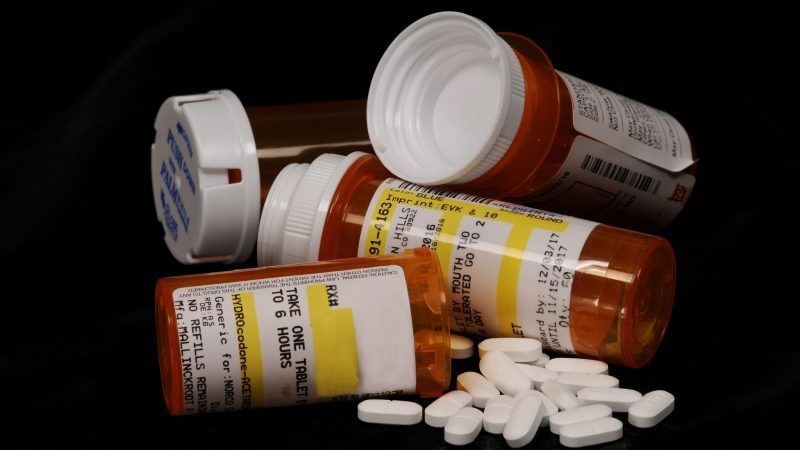A New Pain Medication Could Reinforce the Disastrous Crackdown on Prescription Opioids
When the government is systematically interfering with medical decisions, a non-opioid alternative may not actually increase treatment options.

Vertex Pharmaceuticals is trumpeting the results of clinical trials indicating that VX-548, its new, non-opioid analgesic, is effective at relieving post-surgical pain. While there is nothing wrong with offering patients and doctors another option for treating acute pain, the Phase 3 trials found that VX-548 was no more effective than a combination of hydrocodone and acetaminophen in relieving pain after tummy tucks and less effective for patients who had bunions removed.
As a new drug under patent, VX-548 is bound to be much more expensive than generic versions of Vicodin, and its main selling point seems to be based on a gross exaggeration of that familiar drug's addictive potential. The introduction of VX-548 therefore could reinforce myths about the risks of prescription opioids and encourage the government's misguided and heavy-handed crackdown on those medications.
"People who are suffering from severe pain but don't want to risk addiction to an opioid are closer to a new option for treatment," The Wall Street Journal reports. The Journal claims "opioids are highly addictive," which is not true by any reasonable measure.
A 2018 BMJ study of 568,612 patients who took prescription opioids following surgery found that 5,906, or 1 percent, showed documented signs of "opioid misuse" during the course of the study, which included data from 2008 through 2016. The outcome measure that the researchers used, "opioid dependence, abuse, or overdose," is a broad category that includes patterns of use falling short of what most people would recognize as addiction. That suggests the actual addiction rate in this study probably was less than 1 percent, although it's not clear how much less. The authors noted that "overall rates of misuse were low."
Estimates of addiction rates among patients who take opioids for longer periods of time tend to be higher but still lower than the phrase "highly addictive" suggests. A 2010 analysis in the Cochrane Database of Systematic Reviews found that less than 1 percent of patients taking opioids for chronic pain experienced addiction. A 2012 review in the journal Addiction likewise concluded that "opioid analgesics for chronic pain conditions are not associated with a major risk for developing dependence."
In a 2016 New England Journal of Medicine article, Nora Volkow, director of the National Institute on Drug Abuse, and A. Thomas McLellan, a former deputy director of the Office of National Drug Control Policy, reported that "rates of carefully diagnosed addiction" in chronic pain patients averaged less than 8 percent. In general, they observed, "addiction occurs in only a small percentage of persons who are exposed to opioids—even among those with preexisting vulnerabilities." In 2021, a California judge who examined the relevant evidence likewise estimated that the addiction rate among patients was "less than 5%."
Even a low risk is still a risk, of course, and doctors might prefer to avoid it by prescribing a drug like VX-548. But they should not pretend there are no tradeoffs in terms of cost and effectiveness. The problem is that the government has systematically biased such decisions by discouraging doctors from prescribing opioids in the name of preventing substance abuse.
In response to an increase in opioid-related deaths during the first decade of this century, state and federal officials sought to reduce the prescription of analgesics like hydrocodone and oxycodone. Those efforts included increased scrutiny of doctors' prescribing practices, raids of clinics identified (rightly or wrongly) as "pill mills," federal pain treatment guidelines, statutory and regulatory limits, and restrictive policies imposed by insurers, pharmacists, and medical facilities under government pressure.
That campaign succeeded in reducing opioid prescriptions, which fell by 44 percent from 2011 to 2020. But it left many patients to suffer needlessly as doctors became increasingly reluctant to prescribe the medication they needed to relieve their pain, and it did not succeed in reducing the number of opioid-related deaths.
To the contrary, the upward trend that prompted the anti-opioid campaign not only continued but accelerated. The opioid-related death rate, which doubled between 2001 and 2010, nearly tripled between 2011 and 2020. In 2021, the Centers for Disease Control and Prevention counted more than 80,000 opioid-related deaths, nearly four times the number in 2010.
What went wrong? Restrictions on opioid prescribing pushed nonmedical users toward black-market substitutes that were much more dangerous because their composition was highly variable and unpredictable. That hazard was compounded by the rise of illicit fentanyl, which likewise was driven by efforts to enforce drug prohibition. Fentanyl, which is 30 to 50 times more potent than heroin, appeals to drug traffickers because it is much cheaper to produce and much easier to conceal. Nowadays it is showing up not just in powder sold as heroin but also in ersatz pain pills that resemble the medications that the government has made harder to obtain, with predictably deadly consequences.
Bona fide pain patients, meanwhile, were left in the lurch as physicians began to see them as a threat to their licenses, livelihoods, and liberty. The horrifying fallout included undertreatment, abrupt dose reductions, patient abandonment, and unrelieved pain severe enough to result in suicides. This is what happens when the government insists that doctors prioritize prevention of opioid abuse above patient welfare and their own medical judgments. Patients paid the price of policies that manifestly failed to reduce opioid-related deaths and instead had the opposite effect.
The availability of non-opioid analgesics like VX-548 should expand pain treatment choices. But in the current political context, it is apt to limit choices instead, reinforcing propaganda and policies that discourage the use of opioids even when they are medically appropriate.


Show Comments (44)